Windows 7 (2010)
Mojave experiment (2008)
Oslo (2007)
Windows Home Server (2007)
Microsoft Expression Studio (2007)
Windows DreamScene (February 13, 2007)
Groove (2007)

Microsoft Office 2007 (January 30, 2007)

Windows Vista (January 30, 2007)
Windows Communication Foundation (November 2006)
Windows PowerShell (November 14, 2006)

Novell and Microsoft announced a joint patent agreement to cover their respective products (November 2, 2006)
Windows Defender (October 24, 2006)
Internet Explorer 7 (October 18, 2006)
Virtual PC (July 2006)
Zune (July 2006)
Bill Gates announced his plans for a two year transition period (June 15, 2006)
out of a day-to-day role with Microsoft until July 31, 2008
Microsoft adCenter (2006)
Windows Live (2006)
Windows Live OneCare (May 31, 2006)
Windows Genuine Advantage (April 25, 2006)
Ultra-Mobile PC (2006)
MS Virtual Earth (December 2005)
Xbox 360 (November 22, 2005)
Visual Studio 2005 (October 2005)
Windows XP Media Center Edition (October 12, 2004)
Channel9 (April 2004)
the ordered Microsoft to pay €497 million (US$613 million) (March 2004) in the European Union Microsoft antitrust case
Microsoft Fingerprint Reader (2004)
Infopath (November 2003)
Paul Vick's Panopticon Central (2003)
Imagine Cup (2003)
Singularity (2003)
Empower for ISVs
MSDN Action Pack
Microsoft Certified Professional ()
MapPoint ()
Microsoft Office 2003 (November 17, 2003)
OneNote (October 21, 2003)
Windows Server 2003 (April 24, 2003)
![]()
the .NET Framework (January 16, 2002)
C# (2001)
Xbox (November 15, 2001)
Windows Messenger (2001)
MSN TV (2001)

Windows XP (October 25, 2001)
Windows SharePoint Services (2001)
Office XP (May 31, 2001)
Microsoft Reader (2000)
Visio (2000)

Judge Jackson ordered that Microsoft split into two companies (June 7, 2000) during the antitrust trial in which
the U.S. Department of Justice, joined by twenty U.S. states, alleged that Microsoft abused monopoly power.
A year later the Bush administration Justice Department announced that it will no longer seek a breakup of
Microsoft (Sept. 6, 2001). Already on January 13, 2000 Bill Gates had created a new role for himself --
chairman and chief software architect. Steve Ballmer became president and CEO
Windows Me (2000)
Windows 2000 (2000)
msdn magazine (1999)
Msn messenger (July 22, 1999)
Business at the Speed of Thought (1999)
Office 2000 (January 27, 1999)
10,000-word memo, "The Era Ahead"
the Halloween documents (October 1998)

VB 6 (Summer 1998)
Microsoft Update (1998)
Windows Scripting Host (1998)
Windows Media Player (June 25, 1998)
Windows 98 (June 25, 1998)
United States v. Microsoft (May 18, 1998)
Overdrive: Bill Gates and the Race to Control Cyberspace (1997)
Age of Empires (1997)
Outlook (January 1997)
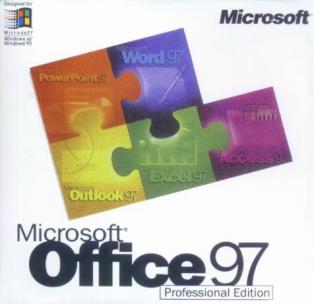
Office 1997 (December 30, 1996)
Remote Desktop (July 29, 1996)
FrontPage (July 29, 1996)
Windows NT 4.0 (July 29, 1996)
Slate (1996)
Windows CE (1996)
MSNBC (1996)
Exchange Server (1996)

The Road Ahead (November 1995)
Internet Explorer (August 1995)
Microsoft hosted an Internet Strategy Day (1995) and announced
its commitment to adding Internet capabilities to all its products
DreamWorks Interactive (1995)
DirectX (1995)
Microsoft Plus! (1995)
Microsoft PowerToys (1995)
Bill Gates' house (1995)
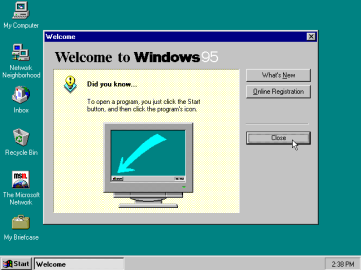
Windows 95 (August 24, 1995) launched and sold more than 1 million copies in four days
Internet Information Services (May 30, 1995)
Microsoft Bob (March 1995)
MSN (1995)
MS BackOffice Server (1994-2001)
NTFS (July 1993)
Windows NT (July 1993)

Encarta (1993)
Component Object Model (1993)
Access (November 1992)
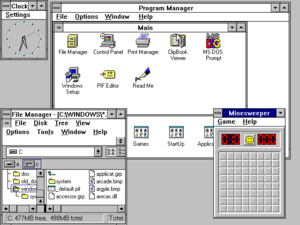
Windows 3.1 (August 1992) was released two years after Version 3.0
Andrew Schulman's Undocumented Windows (1992) A Programmer's Guide to Reserved Microsoft Windows API Functions
Hard Drive: Bill Gates and the Making of the Microsoft Empire (1992) by James Wallace and Jim Erickson
Jet Database Engine (1992)
WinHEC (1991)
Publisher (1991)
Microsoft Research (1991)
Microsoft Money (199?)
MSDN (1991)
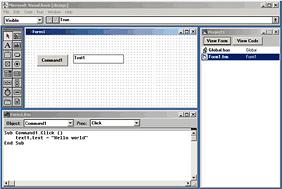
Visual Basic 1.0 (May 1991) was released for Windows
Microsoft Windows Entertainment Pack (1990)
MS-Works for Windows (1990)
Microsoft Office 1.0 (1989)
Corbis (1989)
SQL Server (January 13, 1989)
LAN Manager (1988)
Microsoft Bookshelf (1987)
Power Point (1987)
OS/2 (1987)
Project (1987)
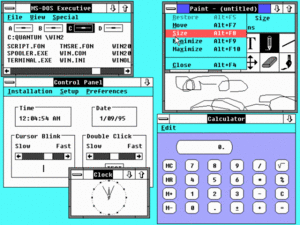
Windows 2.0 (December 9, 1987) was released, with icons & overlapping windows
Microsoft Works, an integrated program with word processor, spreadsheet, database, and communications modules, is introduced for the Macintosh.
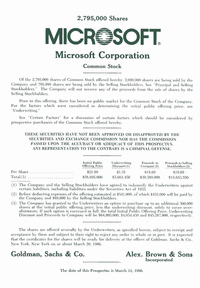
Microsoft stock goes public at $21.00 per share (March 13, 1986) rising to $28.00 per share by the end of the first trading day

the company moved its headquarters to Redmond (March 1986)
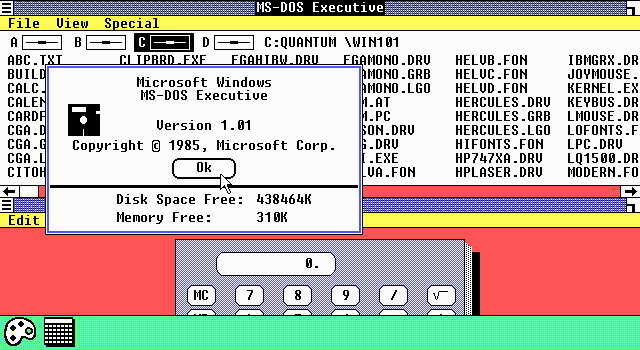
Microsoft Windows 1.0 (November 1985) was Microsoft's first attempt to implement a
multitasking graphical user interface-based operating environment on the PC platform.
Excel (1985)
MS Mail (1980s)

Microsoft Word (1983) for MS-DOS 1.0
Microsoft Sort (1983)
Jon Shirley became president (1983)
Microsoft Press (July 11, 1983)
Microsoft Mouse (May 2, 1983)
Paul Allen resigned as Microsoft's Executive Vice President (February 18, 1983) but remained on the Board of Directors
MSX (1983)
MultiPlan (1982)
Microsoft Flight Simulator (1982)
James Towne, was appointed president and chief operating officer (June 25, 1982) he resigned one year later
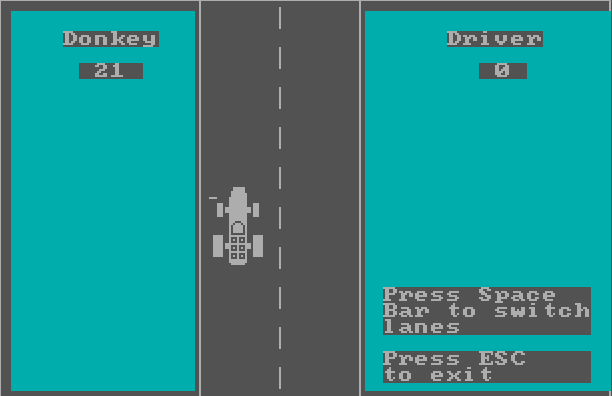
Donkey.bas (1981)
MS Adventure

MS Dos (1981)
Embrace, extend and extinguish
the company restructured (June 25, 1981) to become an incorporated business
in its home state of Washington with a further change of its name to "Microsoft, Inc."
Steve Ballmer joined the company (June 11, 1980)
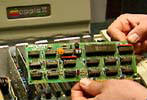
Softcard (March 1980)
Xenix (1979)
the company moved from Albuquerque (January 1, 1979) to a new home in Bellevue, Washington
Microsoft's year-end sales exceeded $1 million (1978)
ASCII Microsoft, the company's first international sales office, opens in Japan (1978)
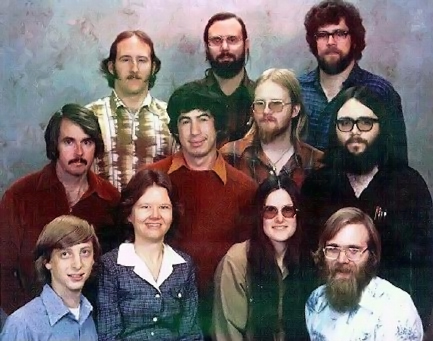
(December 7, 1978)
ASCII Microsoft (1978)
Microsoft FORTRAN
Microsoft COBOL
Microkids (1976)
the Fat file system (1976)
Open Letter to Hobbyists (February 3, 1976)
Micro-Soft (April 4, 1975) was founded by Bill Gates and Paul Allen
Paul Allen joined MITS (Micro Instrumentation and Telemetry Systems) as Director of Software (March 1, 1975)
Bill Gates and Paul Allen completed Altair BASIC (February 1, 1975)
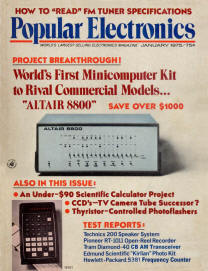
after reading the Popular Electronics issue (January 1, 1975) that demonstrated the Altair 8800, Bill Gates called the
creators of the new microcomputer, MITS (Micro Instrumentation and Telemetry Systems), offering to demonstrate an
implementation of the BASIC programming language for the system. Gates had neither an interpreter nor an Altair system,
yet in the eight weeks before the demo he and Allen developed the interpreter. The interpreter worked at the demo and MITS
agreed to distribute Altair BASIC. Gates left Harvard University, moved to Albuquerque, New Mexico where MITS was
located, and founded Microsoft there
Traf-o-Data (1972)
Lakeside Programmers Group